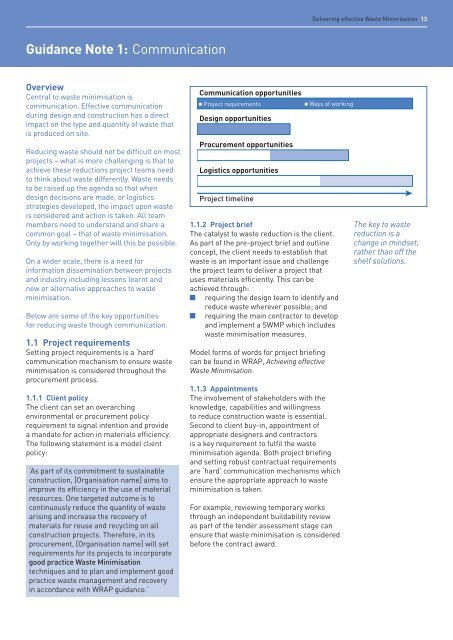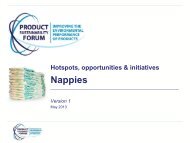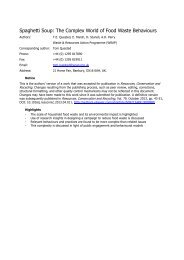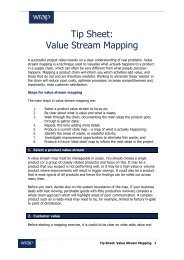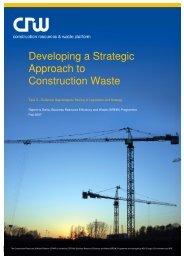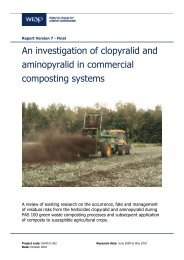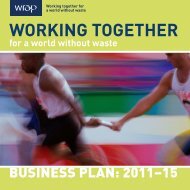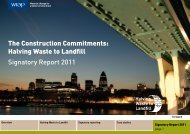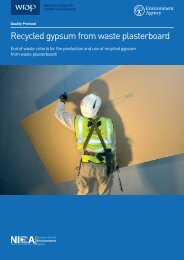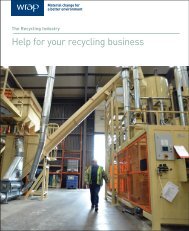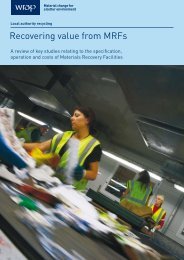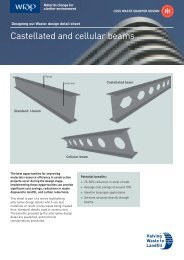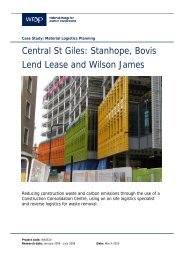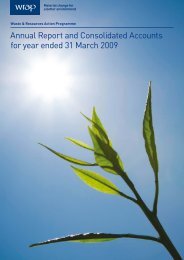Delivering effective Waste Minimisation - Wrap
Delivering effective Waste Minimisation - Wrap
Delivering effective Waste Minimisation - Wrap
Create successful ePaper yourself
Turn your PDF publications into a flip-book with our unique Google optimized e-Paper software.
<strong>Delivering</strong> <strong>effective</strong> <strong>Waste</strong> <strong>Minimisation</strong> 13<br />
Guidance Note 1: Communication<br />
Overview<br />
Central to waste minimisation is<br />
communication. Effective communication<br />
during design and construction has a direct<br />
impact on the type and quantity of waste that<br />
is produced on site.<br />
Reducing waste should not be difficult on most<br />
projects – what is more challenging is that to<br />
achieve these reductions project teams need<br />
to think about waste differently. <strong>Waste</strong> needs<br />
to be raised up the agenda so that when<br />
design decisions are made, or logistics<br />
strategies developed, the impact upon waste<br />
is considered and action is taken. All team<br />
members need to understand and share a<br />
common goal – that of waste minimisation.<br />
Only by working together will this be possible.<br />
On a wider scale, there is a need for<br />
information dissemination between projects<br />
and industry including lessons learnt and<br />
new or alternative approaches to waste<br />
minimisation.<br />
Below are some of the key opportunities<br />
for reducing waste though communication.<br />
1.1 Project requirements<br />
Setting project requirements is a ‘hard’<br />
communication mechanism to ensure waste<br />
minimisation is considered throughout the<br />
procurement process.<br />
1.1.1 Client policy<br />
The client can set an overarching<br />
environmental or procurement policy<br />
requirement to signal intention and provide<br />
a mandate for action in materials efficiency.<br />
The following statement is a model client<br />
policy:<br />
‘As part of its commitment to sustainable<br />
construction, [Organisation name] aims to<br />
improve its efficiency in the use of material<br />
resources. One targeted outcome is to<br />
continuously reduce the quantity of waste<br />
arising and increase the recovery of<br />
materials for reuse and recycling on all<br />
construction projects. Therefore, in its<br />
procurement, [Organisation name] will set<br />
requirements for its projects to incorporate<br />
good practice <strong>Waste</strong> <strong>Minimisation</strong><br />
techniques and to plan and implement good<br />
practice waste management and recovery<br />
in accordance with WRAP guidance.’<br />
Communication opportunities<br />
• Project requirements<br />
Design opportunities<br />
Procurement opportunities<br />
Logistics opportunities<br />
Project timeline<br />
1.1.2 Project brief<br />
The catalyst to waste reduction is the client.<br />
As part of the pre-project brief and outline<br />
concept, the client needs to establish that<br />
waste is an important issue and challenge<br />
the project team to deliver a project that<br />
uses materials efficiently. This can be<br />
achieved through:<br />
requiring the design team to identify and<br />
reduce waste wherever possible; and<br />
requiring the main contractor to develop<br />
and implement a SWMP which includes<br />
waste minimisation measures.<br />
Model forms of words for project briefing<br />
can be found in WRAP, Achieving <strong>effective</strong><br />
<strong>Waste</strong> <strong>Minimisation</strong>.<br />
• Ways of working<br />
1.1.3 Appointments<br />
The involvement of stakeholders with the<br />
knowledge, capabilities and willingness<br />
to reduce construction waste is essential.<br />
Second to client buy-in, appointment of<br />
appropriate designers and contractors<br />
is a key requirement to fulfil the waste<br />
minimisation agenda. Both project briefing<br />
and setting robust contractual requirements<br />
are ‘hard’ communication mechanisms which<br />
ensure the appropriate approach to waste<br />
minimisation is taken.<br />
For example, reviewing temporary works<br />
through an independent buildability review<br />
as part of the tender assessment stage can<br />
ensure that waste minimisation is considered<br />
before the contract award.<br />
The key to waste<br />
reduction is a<br />
change in mindset,<br />
rather than off the<br />
shelf solutions.


